SPH-4 series helmets
Main source for service and development
related information: USAARL Report No. 91-11 'SPH-4 Aircrew Helmet Impact Protection
Improvements 1970-1990' by Ronald W. Palmer, Biodynamics Research Division, United States
Army Aeromedical Research Laboratory, February 1991.SPH-4
The Sound Protective Helmet-4 (SPH-4) is a derivative of the US Navy SPH-3 and was used by
the US Army since 1970. The SPH-4 is a single-visor lighter-weight version of the SPH-3
and it replaced the two Army aircrew helmet then in use: The Navy-developed Aircrew
Protective Helmet no 5 (APH-5) and the Army-developed Anti-fragmentation Helmet No. 1
(AFH-1). Both of these helmets were deficient in noise attenuation and retention
capability. The SPH-4, which was specifically designed for sound protection, provided
superior sound attenuation but the 1970 version provided no more impact protection than
the APH-5A. As the sciences of crashworthiness and head injury prevention developed, it
became evident that head injuries could be reduced by modifying the SPH-4.
Two types of head injury that might be prevented continued to occur after the introduction
of the SPH-4. One was concussions severe enough to prevent the crewmember from saving
himself from the crash site, and the other was skull fractures due to blows from the side
(lateral). Furthermore, helmet retention proved to be a problem as well. A helmet can only
protect a crewmember if it stays in place and it turned out that one in five crewmembers
involved in severe crashes lost their helmet.
The original SPH-4 had a shell made of fibreglass cloth
layers bonded by epoxy. The inner polystyrene foam energy absorbing liner was 97 mm
(0.38") thick with a density of 5.2 lb/ft3. The helmet was fitted with a
sling suspension liner and had a nape strap with a single snap on each side fitting to
studs on a retention harness. The chin strap had a design strength of 150 lbs. The headset
was mounted in 6 mm thick moulded plastic ear cups with excellent sound attenuation
characteristics. A size regular helmet weighed 1.54 kg (3.4 lbs).
In 1974 the SPH-4 was modified with a thicker energy absorbing liner to reduce the risk of
concussions. The new liner was 1.27 cm (0.50") thick and with the same density as the
original liner. In 1982 the risk of concussions was reduced even further by manufacturing
the energy absorbing liner with a lower density 4.5 lb/ft3. All in all the
impact protection was improved about 33% over the original SPH-4 from 1970.
Nothing was done to the original SPH-4 design to reduce the risk of skull fractures due to
blows from the side. The main culprit was the rigid plastic ear cups that turned out to be
too strong in comparison with the skull around the ears. In case of a strong blow from the
side the ear cup survived but the skull fractured. This problem was not addressed until the
SPH-4B helmet was fielded.
Helmet retention, however, was improved. The original 1970 helmet had a chinstrap with
single snap fasteners on each side and was designed to withstand a load of 150 lbs. In
1978 a double-Y chinstrap with two snap fasteners was incorporated to reduce failures.
This chinstrap had a failure limit of 250 lbs based on the adjustment buckle strength. In
1980 a third chinstrap was introduced. It was fastened to the ear cup assembly on one side
with a small screw and T-nut, and the other side with two snap fasteners. This chinstrap
had a failure limit of 300 lbs but some failed at 280 lbs.
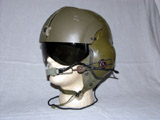 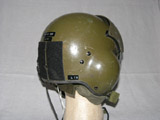 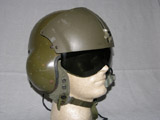 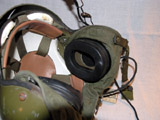
SPH-4 helmet updated with new retention assembly, nape strap
and thicker energy absorbing liner. The velcro
patches on the back of the helmet look like those normally associated with a night vision
goggle battery pack. It
strongly suggest that this helmet once was equipped with a visor housing with an NVG
mount.
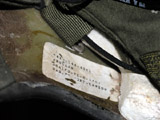 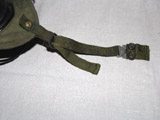 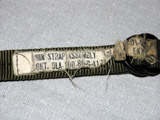 
Far Left: This helmet was manufactured by
Gentex to a 1971 order (DSA100-71-C-1457). Centre Left: The 300
lbs chin strap introduced in 1980. It is fastened to the retention assembly with a screw
and T-nut in one side and two
snaps in the other. Centre Right: This particular chin strap was ordered
in 1986... Far Right: ... and so was the
energy absorbing liner. All pictures © Bluelight
SPH-4B
Seen in retrospect the SPH-4B was only a stop gap measure between the modified SPH-4 and
the HGU-56/P helmet.
Message 1855, Mar 26, 2004
Hi Shark and the rest of the group. Regarding the SPH-4 in Navy service, you would have to
go back a ways, but the original SPH-3 had a single visor housing. If I had it close by, I
could read the tag for you from the one in the collection, but it is dated 1965 and is
clearly an SPH-3. The SPH-3B I believe may have incorporated the dual visor system as part
of the change in designation. With that said, there is another part to the story.
I at one time, picked up an SPH-4 that was painted white, and had been fit with a VERY
early Navy ( complete with decal ) single visor housing, but had US Army comm gear. Not
long after this, I read an article about how the navy acquired a bunch of ex-Army UH-1
Hueys helo's to use in river interdiction missions and support of the brown water navy as
it was called. My thoughts on the odd white painted SPH-4 with the navy housing was that
maybe the ex Army helo's may have still been fit with Army type comms, so helmets may have
been, necessarily SPH-4's, but made a bit more 'appropriate " with the addition of
the white paint and Navy acknowledgment on the housing.
The visor housing on this helmet was of the type made of fiberglass and using the unique
wire frame attached to the shell for the visor lock knob to fastens to......it locks
completely independently of the housing itself and often uses a knurled aluminum lock knob
instead of the more common plastic type ( it has a very wide slot therefore and is easily
recognized ) . It is of note, that with the 1965 date on the SPH-3, this basic type of
shell / helmet was in use by the Navy at least 3 years before the US Army started issuing
the SPH-4 to their aircrews. Just another possibility !
Any other thoughts ? Regards, Milehigh
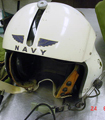 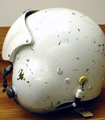   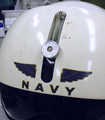 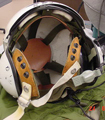
Milehigh's own comments to the pictures run as follows,
"Things of note....
Visor housing and lock knob track, discoloration of paint on rubber comm
cord grommet ( it was painted a long time ago ) and white chin strap,
though I don't know the significance of this other than it is not the green
Army type and last the poor paint job over the standard Army green shell.
The main reason I believe the helmet to be an original Navy thing, and not
some joker making his own USN helmet is the visor housing and the fact
you rarely see these let alone have a parts set around to bother locating
and drilling ( correctly I might add ) to an Army shell, when you could just
paint what you had ! These types of visor / lock knobs show up on BPH
helmets ( these date from as early as 59' ! ) plus this is what that DH-71
helmet of mine has though slightly different knob." © Milehigh
Message 1382:
To help you with your quandrum of the SPH model types... While the helmet in reality is
the same beast, in regards to the SPH-4B/AF/CG helmets & SPH-5AF/CG/CF
helmets, all TPL liner configured. No V-Tec or web suspension in any of these models. The
helmet color & harness tends to differ between them and of course the Gentex white
sticker with model type and production lot numbers changes from model to model as can
be expected. The 4 models tend to be Kevlar built and the 5's Graphlon built. Best
Regards, Kirk Sunley
|













